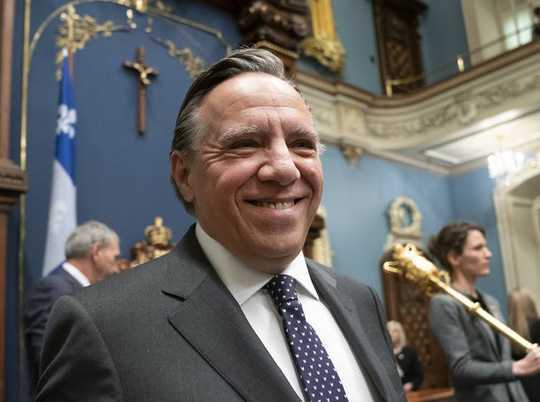 Coalition Avenir Québec leader François Legault on the campaign trail last September before the election that saw his party form a majority government. THE CANADIAN PRESS/Ryan Remiorz
Coalition Avenir Québec leader François Legault on the campaign trail last September before the election that saw his party form a majority government. THE CANADIAN PRESS/Ryan Remiorz
The Québec government is proposing a secularism law to prohibit any new public servants in a position of authority — including teachers, lawyers and police officers — from wearing religious symbols while at work.
The bill incorporates the language of the law from last year’s Bill 62, which prohibits people from wearing face coverings when they receive government services — including health care and day care services and using public transit.
Bill 21, An Act Respecting the Laicity of the State, follows laws previously put forth by Québec’s governments — the Liberal Party in 2010 and 2017 and the Parti Québécois in 2013. But parts of these law were suspended after court challenges.
This time, the provincial government invoked the “notwithstanding clause” to ensure it holds up against constitutional scrutiny. The clause allows provincial or federal authorities to override sections of Canada’s Charter of Rights.
The bill also proposes to permanently amend the Québec Charter of Human Rights and Freedoms to accommodate state laïcité, the French principle of strict separation between church and state.
Christian culture as the norm
In my research at Carleton University, I have been tracking what I call “Christian liberalism.” I look at the role of religion within the liberal democratic state — and how Christian frameworks, norms and values are embedded into the history of law and public policy in the United States and Canada.
At first glance, the strict secularism (or laïcité) of Bill 21 appears intolerant of religion in all its public forms. But the neutral and secular language of the bill presumes an invisible Christian default when outlining the rules around public expressions of religiosity.
 Quebec Premier Francois Legault last week as his government voted on Bill 21. The crucifix behind him would likely disappear if the legislation is passed. THE CANADIAN PRESS/Jacques Boissinot
Quebec Premier Francois Legault last week as his government voted on Bill 21. The crucifix behind him would likely disappear if the legislation is passed. THE CANADIAN PRESS/Jacques Boissinot
For example, the Charter of Values put forth by the Parti Québécois in 2013 proposed banning “conspicuous” religious symbols from the public service sector. But it drew a line between “subtle” religious expressions (like a crucifix necklace) and “overt” ones (like the Islamic headscarf).
The language of conspicuousness reveals that what is determined to be permissible religious expression is a “familiar” and historically embedded Christian understanding.
Constitutional threats
The use of the notwithstanding clause and the proposal to amend the province’s Human Rights Charter pose real constitutional threats. Given the rise in hate crimes targeting racialized and religious minority groups in Canada, the 2017 terrorist attack on a Québec City mosque and the recent attack in Christchurch, New Zealand, the suspension of religious freedom rights should raise alarms.
Bill 21, like the previous secularism bills, disproportionately targets religious minorities.
According to the non-profit human rights group the National Council of Canadian Muslims, the bill amplifies anti-Muslim sentiment. Many news op-eds express the same view: that the bill could intensify polarizing attitudes in Québec.
Liberal tolerance
The western liberal notion of “tolerance” comes from the 17th-century English philosopher John Locke, who considered religious pluralism beneficial to a healthy democracy. Locke’s ideas, grounded in Christian moral reasoning, became the basis for religious freedom protections embedded in liberal democratic constitutions.
In A Letter Concerning Toleration published in 1689, Locke argued that the state should stay out of the business of regulating religious expressions. He advocated for the inclusion of religion in public, so long as it did not contradict state laws. He extended religious tolerance to Christian churches, and also Pagans, Muslims and Jewish people.
But Locke’s understanding of tolerance was rooted in Christian logic and informed by his Calvinist upbringing. He held to the idea of “the true religion” and did not believe atheists should receive the same tolerance.
Wendy Brown, professor of political science at the University of California Berkeley, argues that Locke’s premise is culturally condescending: it reproduces a hierarchical relationship between those who do the tolerating and those who must be tolerated.
The use of terms like “neutrality” and “secularism” along with Bill 21’s “laicity” employ the same rhetoric of tolerance espoused by Locke.
Religious and cultural heritage
Despite the Quiet Revolution of the 1960s, when the role of the Catholic Church was considerably diminished, Québec society retains the cultural residue of Catholicism.
The proposed religious symbols bans make special exemptions for expressions that affirm “elements of Québec’s cultural heritage, in particular, its religious cultural heritage.” This wording allows Catholic symbols, like the crucifix hanging in the National Assembly, to remain. Although the Coalition Avenir Québec (CAQ) government has agreed to move the crucifix, Bill 21 retains this language of exemption.
By putting forward this proposed law, the CAQ positions the state as arbiters of religious authority. They determine which symbols are interpreted as “religious” — and therefore in violation of the law — and which are merely “cultural” expressions of Catholic heritage.
In this way, Christianity remains the invisible cultural default. Unless that default is made visible, Canadian laws will not be able to get beyond the condescending premise of tolerance and move towards genuine inclusion.![]()
About The Author
Hannah Dick, Assistant Professor, School of Journalism and Communication, Carleton University
This article is republished from The Conversation under a Creative Commons license. Read the original article.
Related Books
at InnerSelf Market and Amazon
























